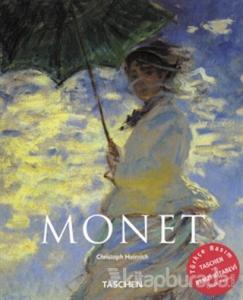Teknik Bilgiler
Stok Kodu
9783836531344
Boyut
245-305
Sayfa Sayısı
96
Basım Yeri
İstanbul
Baskı
1
Basım Tarihi
2011-12
Kapak Türü
Karton
Kağıt Türü
2.Hamur
Dili
Türkçe
9783836531344
505553

https://www.kitapburada.com/kitap/monet-2
Monet
42.50
Lasting impressions of nature
The most typical and the most individual Impressionist painter
Claude Monet (1840-1926) was the most typical and the most individual Impressionist painter. His long life he dedicated to a pictorial exploration of the sensations which reality, and in particular landscape, offers the human eye.
But while Monet the painter was faithful and persevering in the pursuit of his motifs, his personal life followed a more restless course. Parisian by birth, he discovered plein-air painting as a youth in the provinces, where one of his homes, Argenteuil, has come to represent the artistic flowering and official establishment of Impressionism as a movement, with Monet as its creative leader.
In his endeavor to capture the ever-changing face of reality, Monet went beyond Impressionism and thereby beyond the confines of self-contained panel painting: in Giverny he painted the Poplars, Grain Stacks and Rouen Cathedral series in which he addressed one motif in constantly new variations. Here, too, Monet laid out the famous garden with its water-lily pond which he was to paint on huge canvases well into the 1920s. He thereby sought to render not reality as objectively experienced, but rather that which takes place "between the motif and the artist." In their open, merely tenuously representational structure and impressive scale, Monet's water lily paintingscreated long before the currents of the contemporary avant-gardepoint the way to the developments of the future.
The most typical and the most individual Impressionist painter
Claude Monet (1840-1926) was the most typical and the most individual Impressionist painter. His long life he dedicated to a pictorial exploration of the sensations which reality, and in particular landscape, offers the human eye.
But while Monet the painter was faithful and persevering in the pursuit of his motifs, his personal life followed a more restless course. Parisian by birth, he discovered plein-air painting as a youth in the provinces, where one of his homes, Argenteuil, has come to represent the artistic flowering and official establishment of Impressionism as a movement, with Monet as its creative leader.
In his endeavor to capture the ever-changing face of reality, Monet went beyond Impressionism and thereby beyond the confines of self-contained panel painting: in Giverny he painted the Poplars, Grain Stacks and Rouen Cathedral series in which he addressed one motif in constantly new variations. Here, too, Monet laid out the famous garden with its water-lily pond which he was to paint on huge canvases well into the 1920s. He thereby sought to render not reality as objectively experienced, but rather that which takes place "between the motif and the artist." In their open, merely tenuously representational structure and impressive scale, Monet's water lily paintingscreated long before the currents of the contemporary avant-gardepoint the way to the developments of the future.
- Açıklama
- Lasting impressions of nature
The most typical and the most individual Impressionist painter
Claude Monet (1840-1926) was the most typical and the most individual Impressionist painter. His long life he dedicated to a pictorial exploration of the sensations which reality, and in particular landscape, offers the human eye.
But while Monet the painter was faithful and persevering in the pursuit of his motifs, his personal life followed a more restless course. Parisian by birth, he discovered plein-air painting as a youth in the provinces, where one of his homes, Argenteuil, has come to represent the artistic flowering and official establishment of Impressionism as a movement, with Monet as its creative leader.
In his endeavor to capture the ever-changing face of reality, Monet went beyond Impressionism and thereby beyond the confines of self-contained panel painting: in Giverny he painted the Poplars, Grain Stacks and Rouen Cathedral series in which he addressed one motif in constantly new variations. Here, too, Monet laid out the famous garden with its water-lily pond which he was to paint on huge canvases well into the 1920s. He thereby sought to render not reality as objectively experienced, but rather that which takes place "between the motif and the artist." In their open, merely tenuously representational structure and impressive scale, Monet's water lily paintingscreated long before the currents of the contemporary avant-gardepoint the way to the developments of the future.
- Yorumlar
- Yorum yazBu kitaba henüz kimse yorum yapmamıştır.


